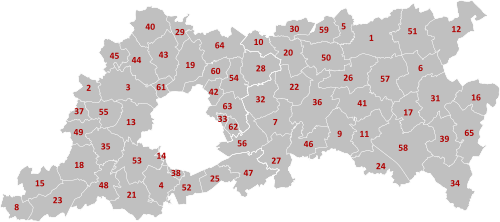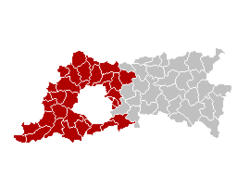Flemish Brabant
Flemish Brabant [4] (Dutch: [Vlaams-Brabant] Error: {{Lang}}: text has italic markup (help), French: [Brabant flamand] Error: {{Lang}}: text has italic markup (help), German: [Flämisch-Brabant] Error: {{Lang}}: text has italic markup (help)) is the youngest and smallest province of the Flemish Region, one of the three regions of Belgium. It covers the Dutch-speaking northern part of the former province of Brabant. Flemish Brabant also completely surrounds the Brussels-Capital Region, which forms an enclave within the territory of the province.
|
Vlaams-Brabant (Dutch) | |
|---|---|
 | |
| Coordinates: 50°55′N 04°35′E / 50.917°N 4.583°ECoordinates: 50°55′N 04°35′E / 50.917°N 4.583°E | |
| Country | |
| Region | |
| Capital (and largest city) | Leuven |
| Government | |
| • Governor | Jan Spooren (N-VA) |
| Area | |
| • Total | 2,118 km2 (818 sq mi) |
| Population (1 January 2022)[2] | |
| • Total | 1,173,440 |
| • Density | 554/km2 (1,430/sq mi) |
| HDI (2019) | 0.946[3] very high · 3rd of 11 |
| Website | www |
Its capital, and also the largest city of the province, is the university city of Leuven (French: [Louvain] Error: {{Lang}}: text has italic markup (help), often used in English).
History
Flemish in Flemish Brabant means that it is in the Flemish part of the former province of Brabant of Belgium. Brabant was an old region, the Duchy of Brabant. The word Brabant appears for the first time in the seventh century when the abbey of Nivelles was founded in the pagus Bracbatensis[5] (pagus is a Latin word meaning a very small town, with only few houses).
Flemish Brabant was created in 1995 by the splitting of the former province of Brabant into three parts: two new provinces, Flemish Brabant and Walloon Brabant; and the Brussels-Capital Region, which no longer belongs to any province.[6] The split was made to accommodate the eventual division of Belgium in three regions (Flanders, Wallonia and the Brussels-Capital Region).
Geography
The province borders on (clockwise from the North) the Belgian provinces of Antwerp, Limburg, Liège, Walloon Brabant, Hainaut and East Flanders.
The province has an area of 2,118 km2 (818 sq mi); it is about 90 km (56 mi) long (east-west direction) and about 40 km (25 mi) wide (north-south direction).
It has a population of about 1,173,000 in 2022.
The province is divided into two districts (arrondissements in French and arrondissementen in Dutch) with 65 municipalities.
The main rivers of the province are the Dyle, the Demer and the Zenne.
Administrative divisions
The province of Flemish Brabant is divided into two districts: Halle-Vilvoorde has Brussels in its middle and, therefore, is mainly a residential area, but it also has large industrial zones; the other district is Leuven, centered on the city of Leuven.

Population by arrondissement
Population x 1,000 (on 1 January since 1980).[7]
| Arrondissement | 1970 ¹ | 1980 ¹ | 1990 ¹ | 2000 | 2010 | 2020 |
|---|---|---|---|---|---|---|
| Halle-Vilvoorde | 418 | 514 | 534 | 558 | 593 | 644 |
| Leuven | 389 | 412 | 430 | 456 | 483 | 512 |
| Province of Flemish Brabant | (807) | (926) | (964) | 1014 | 1077 | 1156 |
The province of Flemish Brabant did not exist before 1995.
Flemish Brabant Media
References
- ↑ "Bodembezetting volgens het Kadasterregister". statbel.fgov.be.
- ↑ "Structuur van de bevolking". statbel.fgov.be.
- ↑ "Sub-national HDI - Area Database - Global Data Lab".
- ↑ Official name is Provincie Vlaams-Brabant (Dutch).
- ↑ "Histoire". Province du Brabant wallon (in French). Archived from the original on 1 September 2013. Retrieved 29 August 2013.
{{cite web}}: CS1 maint: unrecognized language (link) - ↑ "History". Provincie Vlaams-Brabant. Archived from the original on 13 March 2014. Retrieved 5 September 2013.
- ↑ Institut national de statistique - Direction générale Statistique et information économique
Other websites
| Wikimedia Commons has media related to Lua error in Module:Commons_link at line 62: attempt to index field 'wikibase' (a nil value).. |
| Wikivoyage has a travel guide about: Flemish Brabant |
- Official web site of the Flemish Brabant province Archived 2019-11-05 at the Wayback Machine






